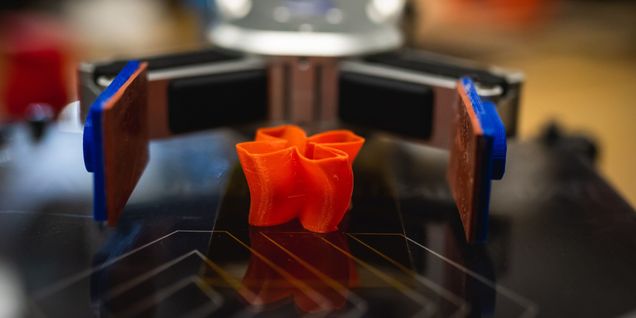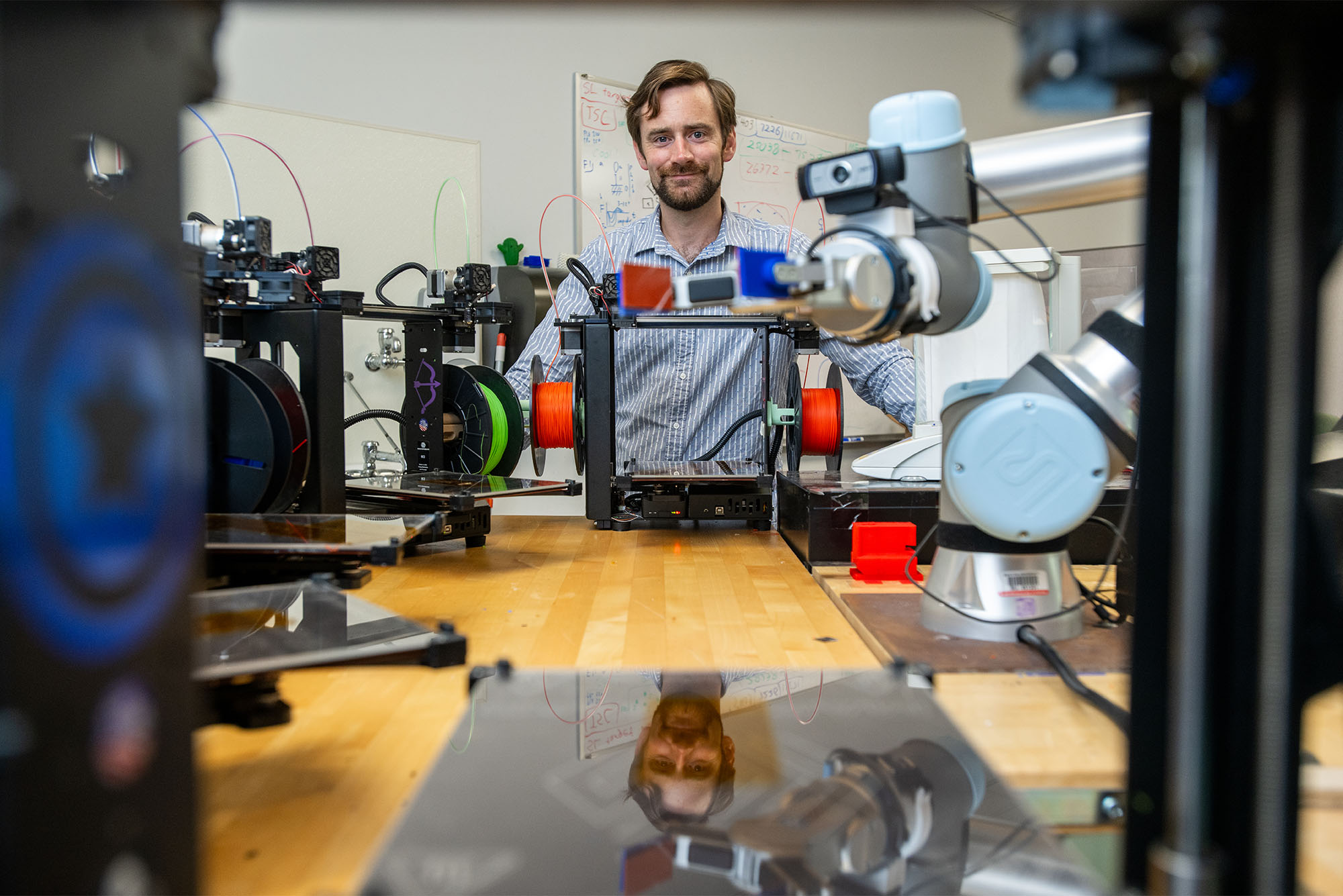Reimagining the Future of Materials Discovery: From Automation to Collaboration
Hariri Faculty Keith Brown (ENG) Leads the Next Evolution of Self-Driving Labs
Self-driving laboratories (SDLs) — research systems that combine robotics, AI, and autonomous experimentation — are transforming discoveries of new and better materials. Capable of running and analyzing thousands of experiments in real time, SDLs accelerate discovery at a scale previously unimaginable.
At Boston University, Associate Professor Keith Brown (MechE, Physics, Materials Science & Engineering) is leading an effort to evolve SDLs from isolated, lab-centric tools into shared, community-driven experimental platforms.
“Most work on self-driving labs focuses on building the lab itself, which is hard because it involves a lot of different disciplines,” says Brown who leads the KABlab at BU. “Our vision is to take the next step: how do we turn it into a shared resource that others can use, pushing beyond the current state of the field.”

Brown is recognized for his pioneering work in SDLs, particularly for developing the record-breaking Bayesian experimental autonomous researcher, MAMA BEAR. Since 2023, the system has conducted over 25,000 experiments with minimal human oversight, achieving a 75.2% energy absorption—the most efficient energy-absorbing material discovered to date, with potential applications in helmet padding and packaging for sensitive equipment.
“We had built a system that could do more experiments than we could ever analyze,” says Brown. “That made us ask — how do we share this? That question became a new passion: building systems that let more people do science together.”
Through a Hariri Institute Focused Research Program (FRP) titled “From Self-Driving Labs to Community-Driven Labs,” Brown and a multidisciplinary team — including Professors Wenchao Li, Emily Whiting, Sean Andersson, and Emma Lejeune — are reimagining SDLs as open collaborative platforms rather than today’s isolated instruments.
“Bringing together researchers from vastly different disciplines — systems experts, mechanical engineers, robotics specialists, and advocates for open data, has already transformed how we think about data, resource access, and exploration, ” says Brown.
Inspired by cloud computing, the team is exploring how opening SDLs to the broader research community could both accelerate discovery and tap into the combined knowledge of the broader materials ecosystem. Pilot initiatives include building infrastructure for external users, testing community-driven experiments, and creating a public-facing interface where users can design experiments, submit requests, and explore data.

Collaborations with external teams, including Professor Peter Frazier’s group at Cornell University, have already produced results. By testing novel Bayesian optimization algorithms on BU’s SDL, researchers discovered structures with unprecedented mechanical energy absorption — doubling previous benchmarks from 26 J/g to 55 J/g, opening new possibilities for advanced lightweight protective equipment.
This year, the group also explored how AI could make research more accessible. They developed a large language model (LLM)–based agent that helps users navigate experimental datasets, ask technical questions, and propose new experiments using retrieval-augmented generation (RAG), a technique for getting better answers from generative AI.
New opportunities for student involvement were also created. A partnership with BU SPARK! helped develop a web interface to interact with SDL datasets, while collaboration with BU Libraries introduced graduate students to FAIR (Findable, Accessible, Interoperable, Reusable) data practices. As part of this effort, the SDL dataset was made publicly available through BU Libraries, where it has been downloaded 89 times as of June 2025.
Brown credits much of the FRP’s success to the team’s collective effort, including Dr. Kelsey Snapp, who defended their PhD dissertation on SDLs in July 2024.
“Just collaborating has changed how we share data and access resources,” Brown says. “When others suggest experiments, we’re seeing breakthroughs immediately— results that wouldn’t be obvious from traditional simulations. It’s already proving to be a true community resource.”
National Impact and Next Steps
Building on this momentum, Brown will lead BU’s contribution to the NSF Artificial Intelligence Materials Institute (AI-MI) — a multi-university initiative (with Cornell, CUNY, Princeton) that uses AI to accelerate materials discovery for sustainable energy, electronics, and quantum technologies. AI-MI plans to create the AI Materials Science Ecosystem (AIMS-EC), an open, cloud-based portal that couples a science-ready large language model (LLM) with targeted data streams, including experimental measurements, simulations, images and scientific papers.
 “My group will be using self-driving labs to conduct materials experiments with the dual goals of evaluating learning models and rapidly providing new data to train advanced models for materials discovery,” says Brown of the new collaboration. “It is an honor to work with such a great team with the goal of revolutionizing the speed of materials research using the power of AI.”
“My group will be using self-driving labs to conduct materials experiments with the dual goals of evaluating learning models and rapidly providing new data to train advanced models for materials discovery,” says Brown of the new collaboration. “It is an honor to work with such a great team with the goal of revolutionizing the speed of materials research using the power of AI.”
Looking ahead, the FRP will build on these efforts, including hosting Materials Day: From Automation to Collaboration – The Future of Self-Driving Labs, on Friday, October 24, 2025, at BU’s Duan Family Center for Computing & Data Sciences. Co-sponsored by the Division of Materials Science & Engineering and the Hariri Institute for Computing, this annual College of Engineering event will feature keynote speakers, lightning sessions, and a community ideation exercise public exploring the future of community-driven experimentation.
Through the FRP, Keith Brown and his collaborators have laid the foundation for a new era of shared science — one where AI, automation, and human connection work together to make experimentation more accessible, collaborative, and impactful.
“When people think about self-driving labs, they often imagine spaces where robots run experiments without anyone present,” says Brown. “What this project has made clear is how crucial people are to the process. Engaging others taps into the creativity of larger groups, helping projects move forward more quickly. Self-driving labs can operate autonomously, but when people contribute their knowledge and intuition, their potential increases dramatically.”
Reflecting on the year’s progress, Brown noted how the FRP reshaped the team’s approach to collaboration, crediting the Hariri Institute for fostering a collaborative environment that extended well beyond his lab.
“The FRP has given us this community at BU that we can now tap into, helping us explore different facets of this work,” says Brown. “It has been a key catalyst, allowing us to expand our focus from an internal effort to something we can now share more broadly across BU and around the world.”
Adds Yannis Paschalidis, Director of the Hariri Institute and Distinguished Professor of Engineering at Boston University, “This research exemplifies the Hariri Institute’s FRP mission to drive convergent, faculty-led research that advances transformative science. Just as cloud computing democratized high-performance computing, opening self-driving labs to the broader community promises to transform experimental science. We commend Professor Brown and the team for advancing this bold vision — uniting AI, robotics, and human-machine collaboration to transform what’s possible in materials discovery.”
